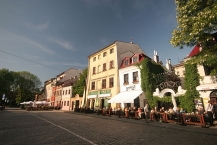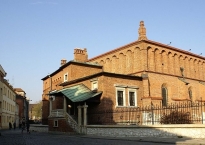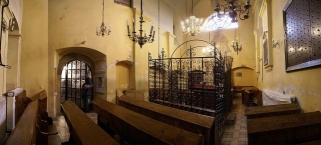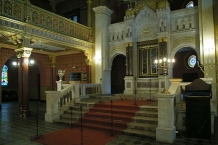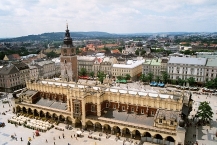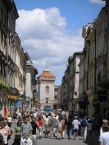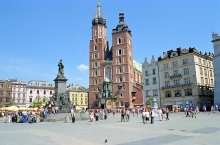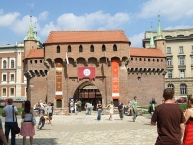Cycle Tour Kraków-Greifswald
Travel report
Actions
![]()
Please wait - map data are loading
Added on 25 Dec 2016,
last edited by HBau on 29 Mar 2020
Actions
Cycle route metrics
planned
ridden
Total distance in km
1.140
1.291
Cumulative elevation gain in m
2.602
26.173
Avg. slope uphill in %
0,23
2,03
Cumulative elevation loss in m
2.806
24.223
Information about rights to the gps-track data | |
|---|---|
Rights owner | HBau & biroto-Contributors |
Rights characteristic / license | cc0: Public Domain no Rights reserved |
Link to the description of the license | |
GPX file taken from | |
GPX file uploaded | by HBau on 28 Dec 2016
|
Track points in total
12.983
23.111
Track points per km (avg)
11
18
Start/endpoint
Start location
Krakow, Lesser Poland Voivodeship, PL (204 m NHN)
End location
Greifswald, Mecklenburg-Vorpommern, DE (0 m NHN)
Beds4Cyclists, worth visiting and infrastructure
Name and address
Latitude / Longitude
Phone
Fax
Mobile
Type of accommodation
Rating for cyclists
Route km
Dist. to route
Elevation
0 km
0,9 km
211 m
Hours of opening
in the season
Monday to Sunday 09:00 - 17:00
off season
Monday to Sunday 09:00 - 17:00
Languages spoken:
polski
0 km
1,1 km
202 m
Information about copyright | |
|---|---|
Rights owner | |
Rights characteristic / license | by-sa: CREATIVE COMMONS Attribution-ShareAlike |
Link to the description of the license | |
Image taken over from | https://commons.wikimedia.org/wiki/File:Szeroka,_Kraków,_2009.jpg |
Image has been uploaded | by biroto-Redaktion on 31 Aug 2016
|
Information about copyright | |
|---|---|
Rights owner | https://commons.wikimedia.org/w/index.php?title=User:Barbara_Maliszewska |
Rights characteristic / license | by-sa: CREATIVE COMMONS Attribution-ShareAlike |
Link to the description of the license | |
Image taken over from | https://commons.wikimedia.org/wiki/File:06660vik_Krakowski_Kazimierz._Foto_Barbara_Maliszewska.jpg |
Image has been uploaded | by biroto-Redaktion on 31 Aug 2016
|
Information about copyright | |
|---|---|
Rights owner | https://commons.wikimedia.org/w/index.php?title=User:Barbara_Maliszewska |
Rights characteristic / license | by-sa: CREATIVE COMMONS Attribution-ShareAlike |
Link to the description of the license | |
Image taken over from | |
Image has been uploaded | by biroto-Redaktion on 31 Aug 2016
|
Information about copyright | |
|---|---|
Rights owner | |
Rights characteristic / license | by-sa: CREATIVE COMMONS Attribution-ShareAlike |
Link to the description of the license | |
Image taken over from | https://commons.wikimedia.org/wiki/File:Krakow_Synagoga_Tempel_20071111_1141_2144.jpg |
Image has been uploaded | by biroto-Redaktion on 31 Aug 2016
|
Kazimierz is a part of Old Town district of Krakow ![]() in Poland. Before World War II, it was a Jewish district.
in Poland. Before World War II, it was a Jewish district.
Understand
Kazimierz was a city founded in 1335 by Polish King Casimir III on an island on the Vistula river. In the 19th century the river branch between Kazimierz and Old Town was dried and built over. After the end of 15th century Jews became an important part of Kazimierz' population as they fled Krakow because of antisemitism. The division of Kazimierz is still visible, the western part with pl. Wolnica and St. Michael's Church (Skałka) was Christian and the eastern with pl. Nowy and ul. Szeroka was Jewish.
Kazimierz became one of Krakow's districts in 1791. In 1943 all Krakowian Jews were forced by the Nazi occupiers to move to the ghetto located in Podgórze and later transported to death camps. After the war uninhabited houses in Kazimierz were populated by a poor and sometimes criminal element, so Kazimierz gained the reputation of the 'bad neighbourhood' in Krakow.
In the 1990s, however, a popular annual Jewish Culture Festival started, the city renovated old synagogues, and new cafes, clubs and galleries opened. In the early 21st century, the district underwent a typical gentrification process and these days rents are really high and small galleries and eateries have started to give way to luxurious hotels.
See
Museums and galleries
- Ethnographic Museum, Town Hall building, Plac Wolnica 1, 'Esterka' building, ul. Krakowska 46, ☎ +48 12 430 5575. Located in the old 15th century Kazimierz town hall. 5 - 9 zł, Mondays closed.
- Museum of City Engineering (Muzeum Inżynierii Miejskiej), ul. św. Wawrzyńca 15, ☎ +48 12 421 1242 wew.100. It is located in old tram sheds and on the grounds of former gasworks and powerplant. It has exhibitions on the history of Polish automotive, public transportation, radio and television, household and office appliances industries. The museum is well prepared for younger visitors. 5 - 8 zł, Mondays closed, Tuesdays free.
- Centre for Jewish Culture (Judaica Foundation), ul. Meiselsa 17, ☎ +48 12 430 6449. Exhibitions, concerts, seminars and workshops on Jewish culture. There is also a cafe (with roof terrace!) and a great antiquarian bookshop located in the basement.
- Galicia Jewish Museum, ul. Dajwór 18, ☎ +48 12 421 6842. 10AM-6PM. The Galicja Museum in Kazimierz houses an exhibition of photographs with explanations in Polish and English. These are recent photographs of locations around Poland associated with the Holocaust. Some are places where massacres occurred; most show old synagogues and Jewish cemeteries with comments about how respectfully (or not) these places are now preserved. The museum also has a bookstore and coffee shop and arranges coach trips to Auschwitz. Tickets are 15 zł or 8 zł with a student discount.
- Jewish Community Centre, ul. Miodowa 24, ☎ +48 12 370 5770. Exhibitions, events, lectures on Jewish culture and language lessons.
Synagogues and prayer houses
Before 1939 there were several dozen synagogues in Kazimierz. After the war most of them were destroyed or converted to residential or public use buildings and their previous function is, after remodeling, imperceptible. Some are still functioning as prayer houses or museums:
- ⊙Old Synagogue, ul. Szeroka 24, ☎ +48 12 422 0962. Built sometime during the 15th century, the synagogue is the oldest still standing synagogue in Poland. It was ransacked by the Nazis during World War II and was renovated between 1956 and 1959. Currently, it serves as a museum documenting Jewish life in Kraków. Adults: 8 zł. Discounted: 6 zł.
- ⊙Remuh Synagogue (Synagoga Remuh), ul. Szeroka 40. Su. - F. 9AM - 6PM. The synagogue and adjoining Jewish Cemetery with the grave of Moses Isserles. Adults: 5 zł. Discounted: 2 zł.
- ⊙Tempel Synagogue, ul. Miodowa 24. Built in 1860 - 1862. Reform synagogue that is open to the public. Since it's an operational synagogue male visitors are expected to wear yarmulke and women should dress somewhat conservatively and have their shoulders covered. During the Nazi occupation, the synagogue was used as a horse stable, but was eventually rededicated to its religious mission. Inside, the synagogue is beautiful, it has a monumental example of Aron Kodesh made from Carrara marble and 43 stained glass windows.
- Bne Emuna Synagogue - corner of ul. Meiselsa and pl. Nowy. The building of Judaica Foundation – Centre For Jewish Culture.
- Chewra Thilim Synagogue - corner or ul. Meiselsa and Bożego Ciała. Today an exhibition space with rare, well preserved polychrome.
- Izaak Synagogue (Isaak Jakubowicz Synagogue) - corner of ul. Kupa and Izaaka. Built in 17th century was considered the most beautiful in Krakow, after the war it was a theater, warehouse and sculpture workshop. Since the 1980s it has been renovated and serves as Jewish Education Centre. Since 2007 it had also been used for religious purposes.
- Kowea Itim le-Tora Synagogue - ul. Józefa 42. Built in 1810 and renovated in 1912 (these dates are written in Stars of David put on the facade). Devastated by Nazis the building became residential after the war.
- Kupa Synagogue - ul. Warschauera 8. Also called Hospital or Poor Synagogue as these were the people it mostly served. After the war it was a warehouse and shoe factory, today it is one of the venues for religious ceremonies and cultural festivals, Jewish Culture Festival among others.
- Mizrachi Synagogue - ul. Kupa 18. Built in 1930s right next to Izaak Synagogue. Since the 80s it serves as a Jewish Culture Centre.
- Wolf Popper Synagogue - ul. Szeroka 16. Was one of the most splendid buildings in Kazimierz, devastated during the Nazi occupation. Today a cultural centre with workshops on dance, art classes, lectures, film screenings, etc.
- ⊙High Synagogue - ul. Józefa 38. Called "high" because the prayer room is on the second floor (this is the only example of that kind in Poland). Third synagogue built in Kazimierz, in Renaissance style. It's in bad condition but conservators are working on the building. It is open to public and photo exhibitions are sometimes put there.
- ⊙Great Mikveh - ul. Szeroka 6, building from 1567 rebuilt at the beginning of 20th century, today Klezmer Hois restaurant and rooms. Ritual bath in the basements, around 40 steep stairs below ground level, can be visited.
Churches
- ⊙Bożego Ciała Church (Corpus Cristi Church) — corner of ul. Bożego Ciała and pl. Wolnica. Gothic Church erected by Kazimierz the Great in 1340. The greatest Italian artist of the Renaissance, Bartholomaeo Berrecci, is buried here. The interior is baroque with a marvelous, high baroque altar and maybe the most beautiful baroque stalls in Central Europe.
- ⊙Katarzyny Church (St. Cathrine's Church) corner of ul. Augustiańska and Skałeczna — Gothic Church erected by Kazimierz the Great in 1363 for the Augustinian Order. There is a beautiful baroque altar and the Renaissance grave of bishop Spytek Jordan inside the church.
- ⊙Michala Church (St. Michael's Church). ul. Skałeczna 15. With the monastery of the Paulins, one of the oldest in Poland. The defensive position of the "Church on the Rock" (Skałka) brought settlement already in the 9th century. Bishop St. Stanislaw is said to be killed there by King Boleslaw II in 1079. The garden pond is traditionally believed to have served for pagan sacrifices. Many famous Poles like Jan Długosz, Stanisław Wyspiański, Adam Asnyk, Karol Szymanowski, Józef Ignacy Kraszewski, Jacek Malczewski, and Czesław Miłosz are buried there.
- Church of Holy Trinity (Church of Merciful Hospitalers) - ul. Krakowska 48. Constructed in 1741 by the Trinities friars in late baroque style, according to a project of architect Franciszek Placidi. The interior of the church was ornamented with rococo stucco decorations and illusion style polychrome.
Cemeteries
- Remuh Cemetery, ul. Szeroka 40. Old Jewish cemetery of Kraków. Located next to Remuh Synagogue was established in 1535. It closed when the new cemetery at Miodowa was opened in year 1800. The most notable person buried at Remuh Cemetery is Rabbi Moses Isserles, others include rabbis of the Jewish communities in Vienna, in Prague and in Kraków and heads of Kraków Talmudic Academy. During Nazi occupation the place was destroyed and tombstones reused as paving stones (in Kraków-Płaszów concentration camp). After the war restoration of the cemetery was attempted, but not many tombstones could be found and today only small fraction of the monuments stands again.
- ⊙New Jewish Cemetery, ul. Miodowa 55. Founded in 1800 and operational until around 1920 when it filled. Nazi Germans closed the cemetery and sold the most valuable tombstones to masons for reuse. After the war some of these were returned. Today cemetery has over ten thousand headstones, renovated brick mortuary, lapidarium and a monument dedicated to Holocaust victims. Many notable people are buried here: rabbis, tzadiks, Jagiellonian University professors, writers and painters (Maurycy Gottlieb).
Information about copyright | |
|---|---|
Rights characteristic / license | by-sa: CREATIVE COMMONS Attribution-ShareAlike |
Link to the description of the license | |
Input taken over from: |
Wikivoyage contributors, 'Kraków/Kazimierz', Wikivoyage, The FREE worldwide travel guide that anyone can edit, 23 July 2016, 11:04 UTC, <https://en.wikivoyage.org/w/index.php?title=Krak%C3%B3w/Kazimierz&oldid=3025276> [accessed 30 August 2016] |
taken over / edited on | 30 Aug 2016 - 09 Sep 2016
|
taken over / edited by |
|
0 km
1,8 km
213 m
0 km
0,2 km
203 m
Hours of opening
in the season
Monday to Sunday 09:00 - 19:00
off season
Monday to Sunday 09:00 - 17:00
Languages spoken:
polski
0 km
1,1 km
Information about copyright | |
|---|---|
Rights owner | |
Rights characteristic / license | by-sa: CREATIVE COMMONS Attribution-ShareAlike |
Link to the description of the license | |
Image taken over from | |
Image has been uploaded | by biroto-Redaktion on 30 Nov 2015
|
Information about copyright | |
|---|---|
Rights owner | |
Rights characteristic / license | by-sa: CREATIVE COMMONS Attribution-ShareAlike |
Link to the description of the license | |
Image taken over from | https://commons.wikimedia.org/wiki/File:Florianska_Krakow_June_2006.jpg |
Image has been uploaded | by biroto-Redaktion on 30 Nov 2015
|
Information about copyright | |
|---|---|
Rights owner | https://commons.wikimedia.org/wiki/Category:Marek_and_Ewa_Wojciechowscy |
Rights characteristic / license | by-sa: CREATIVE COMMONS Attribution-ShareAlike |
Link to the description of the license | |
Image taken over from | |
Image has been uploaded | by biroto-Redaktion on 30 Nov 2015
|
Information about copyright | |
|---|---|
Rights owner | |
Rights characteristic / license | by-sa: CREATIVE COMMONS Attribution-ShareAlike |
Link to the description of the license | |
Image taken over from | |
Image has been uploaded | by biroto-Redaktion on 30 Nov 2015
|
The Old City of Kraków ![]() , referred to in Polish as Stare Miasto, forms the historical kernel of this vibrant Polish city and is the first target for most travellers to the city for accommodation, eating out, entertainment, and attractions.
, referred to in Polish as Stare Miasto, forms the historical kernel of this vibrant Polish city and is the first target for most travellers to the city for accommodation, eating out, entertainment, and attractions.
Understand
The area of the Old City is bounded by the ring of lightly-forested parkland, known as the Planty, that used to mark the Old City walls and moat. The Wawel, the long-fortified hill at the southern end of the Old City, overlooks the River Vistula, and forms an integral part of this district. The centre of the Old City (and of Kraków itself) is the Rynek Główny (Main Market Square) from which all the main streets radiate.
In this article also the area known in Polish as Śródmieście (Inner city) is covered. It was developed behind torn down medieval city walls on the grounds of surrounding villages and towns and today together with Old City forms the I district of Kraków. Śródmieście is bordered by a ring road al. Trzech Wieszczów from the west and rail tracks from the east.
See
Major attractions
- ⊙Wawel Castle, Wawel 5, ☎ +48 12 422 5155. Wawel is a lime hillock situated on the left bank of the Vistula at an altitude of 228 metres above sea level. This is a symbolic place of great significance for Polish people. The Royal Castle and the Cathedral are situated on the hill. Polish Royalty and many distinguished Poles are interred in the cathedral and royal coronations took place there. It's considered to be the most beautiful castle in Central Europe, besides the Hradcany in Prague.
- ⊙Cloth Hall (Sukiennice), Rynek Główny 1-3. Sukiennice was built in the early 14th century in the middle of the Main Market Square as a trading hall in Gothic style. It got its present Renaissance look in 1555. In the 19th century, it was turned into a museum. The first floor was used for great banquets. Now, souvenir shops are there.
- ⊙Town Hall Tower, Rynek Główny 1. Part of the big 13th century Gothic-Renaissance Town Hall that once stood on the Main Market. The town hall was destroyed by the Austrians in the 19th century after they took control of Krakow. It is now one of the branches of Kraków Historical Museum; there's a nice view of the city from upstairs if it is open.
- ⊙Barbican (Barbakan). Barbakan was built in the 15th century as the biggest European defense building of its kind. The Gothic Barbakan was meant to defend the Florian Gate from attacks of the Osman Turks, which were thought to attack Central Europe after conquering Constantinople and the Balkans in the late Middle Age.
- ⊙Florian Gate (Brama Floriańska). This gate is the only part of the medieval walls which has survived. It consists of four towers and the arsenal and gives you a good idea of what the five kilometers of walls around the Old City looked like in the Middle Ages.
Squares
- ⊙Main Market Square (Rynek Główny). A fine medieval square at the heart of the Old City, festooned with churches, restaurants and bars. It is the biggest medieval marketplace worldwide with more than four hectares of area and eleven streets beginning here.
- ⊙Little Market Square (Mały Rynek). A fine medieval square east of the Main Market Square.
- Mary's Square (Plac Mariacki). A small medieval place connecting Main and Little Marketplaces. It was a cemetery in the Middle Ages, but is now a charming and quiet place with the sculpture of a medieval Kracovian student.
- All Saints' Square (Plac Wszystkich Świętych). The name refers to the Gothic All Saints' Church that stood there until the 19th century. Actress Helena Modrzejewska and writer Joseph Conrad lived in houses at this square. There are two beautiful Gothic churches, the St. Francis and the Dominicanus, at its western and eastern ends.
- St. Mary Magdalene Square (Plac św. Marii Magdaleny). A fine square in the center of Okół, the oldest part of the Old Town just under the Wawel. The early baroque St. Peter and Paul Church and the Roman St. Andrew Church are there. In the middle stands the column of Piotr Skarga.
- Stefanus Square (Plac Szczepański). The name refers to the Gothic Stefanus Church that stood there until the 19th century. The secessionist Palace of Art and Old Theatre are there. It was renovated in faux secessionist style, which angered lots of citizens. The fountain plays music in summer evenings.
- Square of the Holy Spirit (Plac św. Ducha). The Gothic Holy Spirit Church is located on the square. Beautiful 19th century Słowacki Theatre is situated there as well.
Churches
- ⊙St. Mary's Church (Bazylika Mariacka), Plac Mariacki 5 (Located on the southern end of the Rynek), ☎ +48 12 422 5518 21. Not during Mass, 12.00-18.00, 14.00-18.00 on Sundays. The first St. Mary's Church was built in 1220. The façade consists of two unequal towers. The tune (hejnał) is played from one of the towers every hour and on Polish Radio at noon. Inside the church, the east wall is taken up by the altar of Veit Stoss (1477-89). It is the largest piece of medieval art of this kind. There is also an altar with a stone crucifix by Veit Stoss. The wall paintings are by Matejko, Wyspianski, and Mehoffer. 6 zł, reduced 3.
- St. Barbara Church — Founded in the 14th century by Mikolaj Wierzynek as a Gothic grave chapel, it was remodeled in the early Baroque style in 1583. It housed a famous Jesuit college which competed with the Jagiellonian University. Next to the main entrance is the Gethsemane, a complex of stone sculptures by Veit Stoss.
- Church of St. Anne (Kolegiata św. Anny), ul. św. Anny 11, ☎ +48 12 422 5318. This church was built in the 14th century and rebuilt in 1407 in Gothic style. It served as the university church. It was rebuilt in baroque style in 1689 by Tylman from Gameren modeled on S. Andrea della Valle in Rome. The corpus of the church was composed of a wide main nave with three pairs of side chapels. The holy professor of theology Jan Kanty is buried there. His baroque grave is one of the most beautiful in Central Europe.
- St. Adalbert's Church (Kościół św. Wojciecha), Rynek Główny. One of the oldest churches in Central Europe. History of the first wooden church on this site dates from 10th century. It is said to have been built by a pagan cult. Holy Adalbert preached before his missionary expedition to Prussia in the late 10th century. It was rebuilt in the 11th century in Romanesque style and enlarged in the 17th century in baroque shape.
- St. Peter and Paul Church, ul. Grodzka 52a. The oldest baroque building in Poland. It was built in 1597 by Jozef Britius for the Jesuit Order and completed by Jan Trevano. The stone façade is based on the Roman church Il Gesu. You can see the longest Foucault's pendulum in Poland (46,5 m) there. Showings on Thursdays.
- St. Andrew Church, ul. Grodzka 56. This is the best example of the Romanesque style in Poland. It was built in the 11th century by Sieciech, palatine of Duke Wladyslaw Herman. The fortifying character of the church is visible and the church was the only place the Krakovians could flee successfully when the Tatars conquered Kraków in 1241. Two beautiful slim Romanesque towers are covered with baroque helmets and the interior is baroque, too.
- St. Giles Church. This church was founded in the 11th century by Duke Wladyslaw Herman as a votive offering for the birth of their son. It was later rebuilt in the Gothic style at the end of the 13th century. The Holy Mass is offered in English on Sundays at 10:30AM.
- St. Trinity Church. St. Trinity Church, a Dominican church, was built in 1222 in Romanesque style (the refectory still is). It was rebuilt as a three-aisled basilica in the second half of 14th century and the 15th century. It is filled with a countless number of tombs and the set of burial chapels of the 16th and 17th centuries was second only to the Wawel Cathedral necropolis. The great fire of 1850 destroyed much of the church. There is an amazing late 14th-century stone portal richly ornamented with carved floral motifs located here.
- St. Mark Church. This was founded in the second half of the 13th century by Duke Boleslaw Wstydliwy. On the wall of the apse stands the sculpted group Golgotha. Inside the church is a rococo pulpit with a worth seeing cross.
- St. Thomas Church, ul. św. Jana. Built in 1618, this church was constructed in early baroque style for the Carmelichans. Later, it was used by the nuns of the hospital of the Holy Ghost.
- Holy Cross Church. It was constructed in 1186. The oldest part of the church is a stone presbytery, while a brick part of the construction dates from the 15th century. The interior is very beautifully decorated with wall paintings dating back to 1420, like 'The Agony in the Garden' in the chapel and a wonderful Gothic palm vault which is based on only one very high pillar.
- St. Martin Church — This church was raised in 1637 in Baroque style for the Discalced Carmelite nuns, but is now a Protestant church. The Gothic crucifix above the altar is one of the oldest in Poland.
- Pijary Church — Built in 1718 by Kasper Bazanka, the late baroque shape of the façade was made by Franciszek Placidi in 1759. It was based on the Il Gesu church in Rome, but aiming to enhance the frontal effect the architect added a decorative top story and flattened the divisions of the elevation.
- St. John's the Baptist and St. John's the Evangelist Church — It was built by Piotr Wlast from Skrzynno in the 12th century in Romanesque style. In the 17th century, the church was altered in Baroque style. The high altar contains a Renaissance painting called "The Mother of God redeeming the Slaves".
- St. Francis Church (Franciscans) — Founded in the first half of the 13th century in Romanique style. In the 15th century, the church received its final Gothic form. In 1850, the grand fire of Kraków destroyed much of the church. The reconstruction and redecoration took several dozen years. The present secession interior was made by Stanislaw Wyspianski. The most authentic part of the church is the northern elevation of the transept, surviving almost intact in its 13th century form. A place of special beauty are the Gothic cloisters surrounding the rectangular viridarium, dating mostly from the first half of the 15th century.
- Reformatory Church of St. Casimir — Built in 1666, together with the monastery in baroque style. In the crypta are graves of the brothers with mummified bodies, due to the special microclimate.
- St. Joseph Church — This church was built in 1694 at the place of the Tęczyński Palace in baroque style. It was damaged in the big fire of 1850 but the interior was saved.
- Church Of Our Lady Of Snows — Constructed in 1632 founded by Anna Lubomirska as a vote to commemorate the victorious battle in 1621 in Chocim against the Osmans. It was destroyed during the Swedish invasion in 1655 and rebuilt in 1671. The main altar has the painting of the "Our Lady of Snows", the gift of Pope Urban VIII. Next to the church stands a cloister with some fragments of the defensive medieval architecture, like a brick tower from the 13th century.
Monasteries
- ⊙Dominicans. The Dominicans came in 1222 to Kraków. After the Tatars destroyed this monastery, they rebuilt it. Duke Leszek, the Black of Kraków, and Bishop Iwo Odrowaz were buried inside the church in the 13th century. Also the great Italian Humanist Fillipo Callimachus was buried there in the 15th century. His grave was made by Veit Stoss and Peter Vischer. There are 13 chapels inside the church, the Sobieski Chapel with graves of the family of king Jan III Sobieski, the golden Myszkowski Chapel full of pretty baroque and gold, the manierist Dominican Chapel by Santi Gucci are the most beautiful. The Renaissance cross ways are full of epitaphs and baroque paintings by Tomasz Dolabella. A beautiful Romanique Crypta is under the cross ways.
- ⊙Franciscans. The Franciscans came in 1237 to Kraków. Their first monastery was destroyed by the Tatars in 1241 and 1259. In 1269, the saint Salomea was buried inside the St. Francis Church. In 1462, 1655 and 1850 parts of the monastery burned. The inside is Gothic and secession. The famous window "Good Father the Creator" by Stanislaw Wyspianski is there. The cross ways are very worth seeing with their Gothic frescoes. It has been a basilica since 1920.
Palaces
- Palace of the Bishops of Krakow (Pałac Biskupow Krakowskich), ul. Franciszkańska 3. Renaissance palace with a beautiful yard. It is world famous as the home of Pope John Paul II. Starting in 1963, he lived there as the bishop/cardinal of Kraków. After he became pope, he always stayed at there while in Kraków. His small talks from the window with Krakowians are famous. Often one can find a candle in the window and many candles and flowers under it.
- Bishop Erazm Ciołek Palace (Pałac Biskupa Erazma Ciolka), ul. Kanonicza 17.
- Palace of Art (Pałac Sztuki), pl. Szczepański 4. Mon-Fri 08:15-18.00, Sat-Sun 10:00-18:00. 10 zł adults, 5 zł reduced.
- Pałac Wielkopolskich (Palace of the Wielkopolskis), pl. Wszystkich Świętych (Town Hall today).
- Pałac Zabarskich (Palace of the Zabarskis), Rynek Główny 20 (Goethe Institut).
- Pałac Pod Baranami (Palace Under the Lambs), Rynek Główny 27.
- Pałac Pod Krzysztofory (Palace under the Krzysztofory), Rynek Główny 35 (Kraków Historical Museum).
Museums
- ⊙Rynek Underground (Podziemia Rynku), Rynek Główny 1 (entrance in Sukiennice opposite the fountain). 10.00–20.00/22.00; closed every first Tuesday of a month. Shows relics of structures hidden under the current Market Square surface. 17 zł, reduced /group 14.
Eat
Budget
- ⊙Gospoda Koko, ul. Gołębia 8, ☎ +48 12 430 2135. 8AM-3AM, yes 3AM!!!. Quite small, quirky self-service restaurant. The menu is in Polish and English. The fare is typically Polish, the daily deal is a soup followed by a main served with a side salad at a fixed price of 14 zł. Half of this for less hungry costs 9.5 zł. 14zł.
Mid-range
- ⊙Cechowa, ul. Jagiellońska 11. Traditional Polish cuisine, not expensive. A TAM exhibition in the pub in the cellar.
- ⊙Chimera, ul. św. Anny 3. Restaurant with traditional Polish cuisine located in a cellar and an inexpensive salad bar (with big variety of salads) located in the yard of a Renaissance house. Beer garden and wine cellar.
- ⊙Jarema, plac Jana Matejki 5. ☎ +48 12 429 3669. Typical Polish and Kresy cuisine, excellent. The service is excellent as well.
Information about copyright | |
|---|---|
Rights characteristic / license | by-sa: CREATIVE COMMONS Attribution-ShareAlike |
Link to the description of the license | |
Input taken over from: |
Wikivoyage contributors, 'Kraków/Old Town', Wikivoyage, The FREE worldwide travel guide that anyone can edit, 15 May 2016, 14:12 UTC, <https://en.wikivoyage.org/w/index.php?title=Krak%C3%B3w/Old_Town&oldid=2996960> [accessed 30 August 2016] |
taken over / edited on | 30 Nov 2015 - 20 Sep 2016
|
taken over / edited by |
|
![]()

